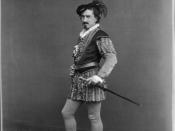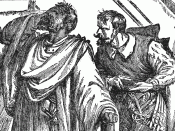"Othello" by William Shakespeare is a tragedy that constructs the play's antagonist Iago, as a two-sided character. Throughout Act I in the play, Iago shows his complex character, who has been presented as racist, manipulative villain, two-faced and jealous. In Act I, Iago complains he hates Othello, as he was not appointed as an officer by him. He plans to cheat Roderigo taking his money and convince Othello, Cassio has slept with Desdemona to bring Othello to destruction. Iago serves a purpose to the play and has been constructed in this way to establish the plot and characters. The audience at this point gain their opinion of characters and clearly know who to sympathise.
Iago is introduced as a racist man from the very beginning of the play. Iago refers to Othello with epithets to suggest Othello as a lust driven animal that is violating the innocent Desdemona.
For instance, he calls Othello, 'an old black ram' who is 'tupping' over Brabantio's "white ewe" (Act I, Scene I, 89-90). He is referring to the fact that Othello is 'a dark skinned man. Iago then associates Othello's colour with the image of 'the devil' (Act1, Scene1, 92) suggesting to Brabantio that he has 'lost half soul' now that Desdemona is married to Othello. This epithets give the audience negative images of Othello and allows them to place prejudicial views. The repetition of the word 'Moor' by Iago abusively implies that Othello is worse than white people and because of his race he should not hold the position he does in the army. Othello's race is supported by an animal imagery 'Barbary horse', (Act1, Scene1, 111) portraying a beasty animal-like image and that this quality will arise throughout the family if Desdemona married...
![From the Library of Congress: TITLE: Thos. W. Keene. Othello CALL NUMBER: POS - TH - 1884 .O7, no. 1 (C size) [P&P] REPRODUCTION NUMBER: LC-USZC6-58 (color film copy transparency) RIGHTS INFORMATION: No known restrictions on publication. MEDIUM: 1 print (](https://s.writework.com/uploads/9/94760/library-congress-title-thos-w-keene-othello-call-number-pos-thumb.jpg)

